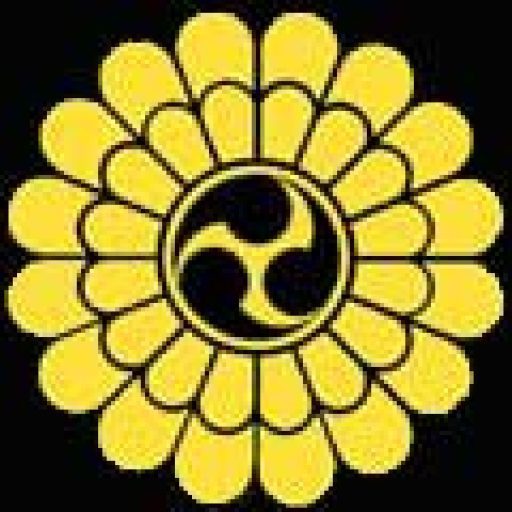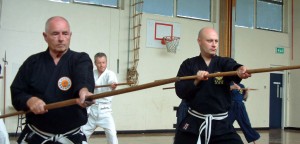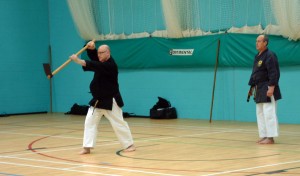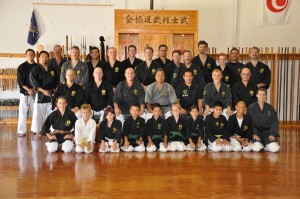Article that Appeared in Martial Arts Magazine
It is my intension to try to briefly explain what Kobudo is and how is has arisen to where we see it today. In addition how Matayoshi Kobudo has evolved into one of the largest systems in the world and how the official Ryu, as represented by the Kodokan in Japan, has developed.
Kobudo is the study of Okinawan weapons which has been said to have evolved throughout their history. In fact the term “kobudo” itself means “ancient martial way”.
If we study the historic relationshi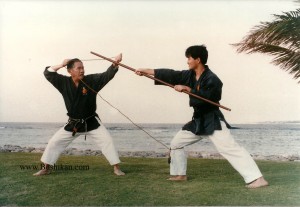 p between Okinawa, China and Japan we can get an idea on how kobudo has developed. However, there is no key point in their history which suggests the origin of kobudo and therefore it is hard to pinpoint an exact date. What we do see is that there are certain times in the Okinawan history whereby kobudo may have originated from. These historic times are now discussed below.
p between Okinawa, China and Japan we can get an idea on how kobudo has developed. However, there is no key point in their history which suggests the origin of kobudo and therefore it is hard to pinpoint an exact date. What we do see is that there are certain times in the Okinawan history whereby kobudo may have originated from. These historic times are now discussed below.
Prior to 1429 Okinawa was divided into three kingdoms, Nanzan, Chuzan and Hokuzan, each ruled by anji who constantly fought for control and therefore Okinawa was used to constant war. So they were familiar with the carrying and the use of weapons. This all changed in 1429 when the Chuzan King, Sho Hashi conquered the Hokuzan kingdom and eventually uniting the three kingdoms together. This started the period in Okinawans history called the “Golden Age of Trade”. The Okinawans enjoyed peace as the First Sho Dynasty began.
Okinawa’s geographical position, in that it was at the crossroads to the trade route to China, Japan and the other Asian countries, enabled it to flourish and its relationship with China grew. There was a boom in cultural exchange between these two nations. It was during the second Sho Dynasty, in 1469, when King Sho En outlawed his subjects to carry and possess weapons. This was to appease China, but also to protect himself from his enemies. The trouble was that China began to see Okinawa as a possible tribute state, but so did Japan.
So the peaceful time ended when Japans feudal leader, Toyotomi Hideoshi ordered the Ryu Kyu Kingdom to support him in the invasion of Korea. This was declined by Okinawa as Korea was a tribute state of China and they did not want to lose their relationship with the Chinese. This decision by Okinawa eventually led Japan to arrange for the Shimazu clan of Satsuma to invade Okinawa. This invasion took place in 1609 whereby two and a half thousand samurai set sail for Okinawa. Shimazu clan were a very strong warrior clan, have gained vast experience in the Japanese wars. The invasion was swift as the Okinawans did not put up much of a fight due to the Shimazu being well trained in combat and the Okinawa King, Sho Nei telling his people that “life itself is a treasure” and to spare themselves any bloodshed.
It was from this period that Okinawa became a vassal state under Satsuma, with Japan having a controlling influence. Shimazu wanted to keep the appearance of Okinawa as a tribute state to China, under their controlling authority in order to keep the trade relations going for their selves and Japan.
During the occupation the Shimazu clan prohibited the Okinawan Pechin class from wearing and the use of weapons. It is a belief in this part of Okinawa’s history that the farming tools of Kobudo evolved as weapons. However, there is no real evidence of this and in fact modern day historians have uncovered evidence to the contrary which suggests it was the Pechin class, and not the farmers of the Heimin class that practiced the study of Kobudo.
Although Japan closed trade relationships to most of the outside world, Okinawans still had good relationship with China and the other Asian countries for trade. The Pechin class were able to travel to these countries, and emissaries could travel to Okinawa exchanging goods and culture. Thereby the Pechin class could study and impart methods of the martial arts, such as karate and kobudo. In fact in their history of the martial arts there is strong evidence of Chinese influence. Most of this training was carried out in secrecy and the systems of the various styles were therefore handed down verbally from master to student. Some of the early practitioners of Kobudo were eminent masters such as Sakagawa Kinga (1733 – 1815) and Chatan Yara (1740 – 1812). In fact it is believed that Sakagawa learnt a lot of his art from China.
Sadly during the Second World War’s Battle of Okinawa the island was devastated. As a consequence a lot of knowledge was destroyed. However, those systems that did survive are still practiced today. Their teachings came from prominent masters, such as Matayoshi Shinko and his son Shinpo, Shinken Taira, Inoue Motokatsu to name but a few.
Matayoshi Shinko (1888-1947)
Matayo shi Kobudo is one of the largest Okinawan Kobudo styles in the world today. The family has a long linage in martial arts going back over nine generations. In fact an early ancestor of the Matayoshi family is said to have served as a strategic martial arts instructor and an officer to the royal court during the last days of the Shoganate. The head of the family, Soke, over the last three centuries can be seen below:
shi Kobudo is one of the largest Okinawan Kobudo styles in the world today. The family has a long linage in martial arts going back over nine generations. In fact an early ancestor of the Matayoshi family is said to have served as a strategic martial arts instructor and an officer to the royal court during the last days of the Shoganate. The head of the family, Soke, over the last three centuries can be seen below:
19th Century:
Matayoshi Shingin
Matayoshi Shintoku
Matayoshi Shinchin
Matayoshi Shinko
20th Century:
Matayoshi Shinko
Matayoshi Shinpo
Matayoshi Yasushi (present day)
21st Century:
Matayoshi Yasushi (present day)
One of the worlds wide known masters in kobudo today is Matayoshi Shinko. The unique style of this family kobudo is due to the strong Chinese influence, and the reason for this influence was down to Matayoshi Shinko Sensei studying the art for over 13 years in China.
Matayoshi Shinko was born in Naha, Okinawa in 1888 to a wealthy business class family. He was the third son of Matayoshi Shinchin, and was the only member of his family to be involved in the martial arts.
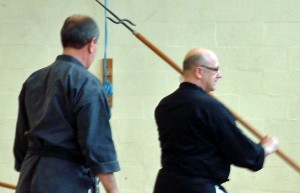 As a teenager Matayoshi Shinko started his training in kobudo under the tutelage of Agena Chokuho Sensei of Gushikawa village. During the period he was exposed to the weapons of Bo, Sai, Ueku, and Kama. Later he became a student of Irei Sensei from Nazato, Chatan Town, where he was taught the art of Tunkua and Nunchaku.
As a teenager Matayoshi Shinko started his training in kobudo under the tutelage of Agena Chokuho Sensei of Gushikawa village. During the period he was exposed to the weapons of Bo, Sai, Ueku, and Kama. Later he became a student of Irei Sensei from Nazato, Chatan Town, where he was taught the art of Tunkua and Nunchaku.
In 1911 at the age of 22, Matayoshi Shinko left Okinawa for adventure in Manchuria. During his time there he joined a nomadic mountain tribe. They taught him how to use the bow and arrow from horseback, called Ba Jutsu, the art of throwing blades, called Shuriken Jutsu, and the art of the lasso, called Nagenawa Jutsu. He spent some time in China and travelling to various parts of Asia studying the martial arts up until 1915. He returned to Japan and during this year he gave a demonstration in Tunkua and Kama at the Imperial Memorial Budo Festival, Meiji Shrine in Tokyo. This was at the same time that Funakoshi Gichin demonstrated his art of Shotokan Karate. As with karate it was the first time Okinawan Kobudo was publically seen in mainland Japan.
Then in March 1921 when the Crown Prince (later Emperor) Hirohito was visiting Okinawa, Matayoshi Shinko gave a demonstration in kobudo, alongside Miyagi Chojun who demonstrated his karate. This was the same year that his son Matayoshi Shinpo was born. The Crown Prince was so impressed with Matayoshi’s kobudo that he awarded him with the Royal Emblem, the Kiku flower emblem to be worn on his gi. This emblem is still worn by the current day practitioners of the Matayoshi Kobudo Kodokan, as allowed by the present day family.
It was when his son Matayoshi Shinpo was around six years old, in 1927, that he introduced him to his kobudo.
Soon after Matayoshi Shinko returned to China, this time visiting Fuchow and Shanghi. While in Fuchow he learnt the art of Chinese boxing, Shoriji Kempo. Then in Shanghi he studied the arts of Nunti, Timbe and Surichin. He also studied herbal medicine and acupuncture under a master called Kinkoroushi.
He eventually returns to Okinawa in 1935 to settle back down in Naha. During this period of his life Matayoshi Shinko incorporates many of the weapons that he has learnt to form the foundation of the Matayoshi Kobudo system. Two years after in 1937 he teaches his son, Matayoshi Shinpo the art of Kingai Ryu Karate.
Matayoshi Shinko was a well respected martial artist in Okinawa and was know as “Kama nu Matehi”, meaning Matayoshi the Kama. Sadly he passed away at an early age of 59 in 1947. However he has left a legacy in which his son took over in this art of Kobudo Jutsu.
Matayoshi Shinpo (1921 – 1997)
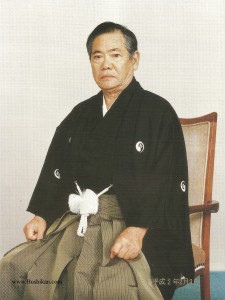 Matayoshi Shinpo was born in Yomitan village located in Nakagami district, Okinawa on 27th December 1921. This was the same year his father gave the demonstration to Prince Hirohito, who stopped over in Okinawa on a visit to Europe. But it wasn’t until the age of 6 that his father introduced Matayoshi Shinpo to martial arts, which included his father’s empty hand of Kingai Ryu.
Matayoshi Shinpo was born in Yomitan village located in Nakagami district, Okinawa on 27th December 1921. This was the same year his father gave the demonstration to Prince Hirohito, who stopped over in Okinawa on a visit to Europe. But it wasn’t until the age of 6 that his father introduced Matayoshi Shinpo to martial arts, which included his father’s empty hand of Kingai Ryu.
In 1937, his father took Matayoshi Shinpo to a Chinese tea importer by the name of Gokeuki Sensei (Wu Xian Gui in Chinese) to learn the art of Hakaku Kempo. Although he had many instructors throughout his life his father was his lifelong instructor and mentor.
It was in 1938 when Matayoshi Shinpo Sensei decided to move from Okinawa to Kawasaki-shi in Kanagawa-ken, mainland Japan. Here he stayed for 19 years in the city of Kawasaki teaching and training in martial arts. After 19 year he decided to return to Okinawa in 1957 in order to teach Kobudo in many of the Goju Ryu dojo, specifically those of Higa Sensei. It was during this period that he realised karate was becoming more popular and growing fast and leaving the art of kobudo behind. So Matayoshi Shinpo Sensei set about to readjust this and to make kobudo as popular amongst the Okinawans. He decided to form his own dojo, which he did in 1960 in Naha. He called his dojo “Kodokan” which means “Hall of the Enlightened Way”. The name was a dedication and memory to his father Sensei Shinko Matayoshi. The kanji “Ko” in Kodokan has a meaning of “light” and is a tribute to “Ko” found in his father’s name Shinko. The weapons studied were Bo (of several lengths), Sai, Nunchaku, Kue, Suruchin, Timbe and Nunti etc.
He then set about uniting Kobudo practitioners all over Japan. His aim was to spread the art of kobudo and to maintain the traditions of the system as passed down from masters from the early days of the art. This was so successful it led him to form the Ryukyu Kobudo Association in 1960, which later in 1972 became the foundation of Zen Okinawa Kobudo Renmei. This organisation still exists to this present day.
Five years after the opening of the Kodokan, in 1965 Matayoshi Yasushi was born who is today’s Soke. In the same year Itokazu Seisho Sensei began his training with Matayoshi Shinpo Sensei in kobudo.
In 1981 Matayoshi Shinpo Sensei first met Sanguinetti Franco Sensei during the first International Okinawan Goju Ryu Karate Federation’s International Gasshuku and Tournament in Okinawa. Sanguinetti Sensei then began his training with Sensei Matayoshi in 1982.
It was in September 1997 that Matayoshi Shinpo Sensei passed away at the age of 76. Like his father before him he had left a legacy in martial arts, and came be seen in numerous videos on the world wide web performing his karate and kobudo. He has now left the mantle to his son Matayoshi Yasushi Soke and to his chief instructor Itokazu Seisho Sensei to carry the Matayoshi Kobudo Kodokan forwards into the future. In addition Sanguinetti Franco Sensei made a promise to Matayoshi Shinpo Sensei to help preserve and spread his father’s kobudo art around the world.
The famous dojo in Naha Okinawa, the Kodokan, is still the Matayoshi family home today, whereby the family lives above the dojo.
Matayoshi Yasushi (1965 – Present)
 Matayoshi Shinpo Sensei second son, Matayoshi Yasushi was born in 1965 and inherited the leadership of the Kodokan Dojo when his father passed. He now continues the work that his father and grandfather had started as Stoke of the Dojo as requested by his father, Matayoshi Shinpo Sensei. Matayoshi Yasushi’s function as head of the Kodokan is extremely important. He provides guidance and spiritual support for the Dojo. This enables it to operate under the same guidelines that his father established. His work is to provide direct support to Itokazu Sensei who was appointed the technical director of the Kodokan in Naha.
Matayoshi Shinpo Sensei second son, Matayoshi Yasushi was born in 1965 and inherited the leadership of the Kodokan Dojo when his father passed. He now continues the work that his father and grandfather had started as Stoke of the Dojo as requested by his father, Matayoshi Shinpo Sensei. Matayoshi Yasushi’s function as head of the Kodokan is extremely important. He provides guidance and spiritual support for the Dojo. This enables it to operate under the same guidelines that his father established. His work is to provide direct support to Itokazu Sensei who was appointed the technical director of the Kodokan in Naha.
Matayoshi Yasushi's involvement with the martial arts is always been renowned. In fact he has been a member of the Board of Directors of the Okinawa-Ken Karate-Do Renmei and President of the Okinawa Prefecture branch of the Dai Nippon Butoku Kai since 1997.
Sanguinetti Franco (1956 – Present)
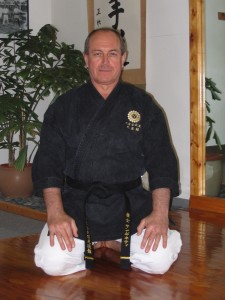 Sanguinetti Franco is the most senior western Matayoshi Kobudo Kodokan instructors outside Japan. He was born in Peru on the 26th January 1956 and began his martial arts training at the age of 16 in 1972. Throughout his budo career he has trained with strict traditional Okinawan and Japanese instructors, such as Juichi Kokubo one of Morio Higaonna direct students; and then with Higaonna himself. Sanguinetti Sensei first met Matayoshi Shinpo Sensei at the International Tournament and Gasshuku for Goju Ryu in Okinawa in 1981. Then during his stay in Okinawa from 1982 to 1983, he trained in three different dojos, and became a direct student of Matayoshi Shinpo in 1982. He has a vast background in the martial arts and a very prominent instructor in both Okinawan Goju Ryu Karate and Matayoshi Kobudo. He is still a member and student of Shihan John Roseberry in the Shorei Shobu Kan. He has competed over 13 years which has earned him the position to compete with the Peruvian National Karate Team and the Venezuelan National Karate Team. He is currently a Nana Dan in both in Karate and Kobudo.
Sanguinetti Franco is the most senior western Matayoshi Kobudo Kodokan instructors outside Japan. He was born in Peru on the 26th January 1956 and began his martial arts training at the age of 16 in 1972. Throughout his budo career he has trained with strict traditional Okinawan and Japanese instructors, such as Juichi Kokubo one of Morio Higaonna direct students; and then with Higaonna himself. Sanguinetti Sensei first met Matayoshi Shinpo Sensei at the International Tournament and Gasshuku for Goju Ryu in Okinawa in 1981. Then during his stay in Okinawa from 1982 to 1983, he trained in three different dojos, and became a direct student of Matayoshi Shinpo in 1982. He has a vast background in the martial arts and a very prominent instructor in both Okinawan Goju Ryu Karate and Matayoshi Kobudo. He is still a member and student of Shihan John Roseberry in the Shorei Shobu Kan. He has competed over 13 years which has earned him the position to compete with the Peruvian National Karate Team and the Venezuelan National Karate Team. He is currently a Nana Dan in both in Karate and Kobudo.
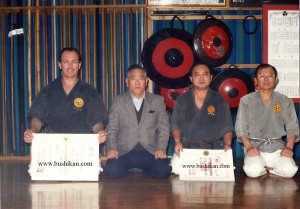 Sanguinetti Franco was awarded his Menkyo (teaching licence) by Matayoshi Shinpo in 1997. He also made a direct promise to Matayoshi Sensei before he passed away to help spread this fine art through out the world. This he is now undertaking, which started by moving to the USA in 1985, where he has a dojo in San Diego, California. From here he formed the Matayoshi Kobudo Kodokan International organization in 1996. It is the honbu dojo for all the other member countries in Australia, Europe, Bermuda, America – north and South, and India. Sanguinetti Sensei travels to all these dojo’s fulfilling his promise he made to his instructor Matayoshi Sensei. In addition he has continued to travel and take groups, every year from the MKKI to the parent dojo in Japan, the Kodoakan to train under Itokazu Sensei.
Sanguinetti Franco was awarded his Menkyo (teaching licence) by Matayoshi Shinpo in 1997. He also made a direct promise to Matayoshi Sensei before he passed away to help spread this fine art through out the world. This he is now undertaking, which started by moving to the USA in 1985, where he has a dojo in San Diego, California. From here he formed the Matayoshi Kobudo Kodokan International organization in 1996. It is the honbu dojo for all the other member countries in Australia, Europe, Bermuda, America – north and South, and India. Sanguinetti Sensei travels to all these dojo’s fulfilling his promise he made to his instructor Matayoshi Sensei. In addition he has continued to travel and take groups, every year from the MKKI to the parent dojo in Japan, the Kodoakan to train under Itokazu Sensei.
Matayoshi Kobudo Kodokan International (1996 – Present)
The MKKI was formed by Sanguinetti Franco in 1996 for the sole purpose to preserve and spread the art of Matayoshi Kobudo as promised by him to his mentor Matayoshi Shinpo. The teaching by Sanguinetti through the MKKI promotes and motivates the members in the system of Matayoshi Kobudo. It also provides other Budo-ka’s the opportunity to train in the official Matayoshi Kobudo as it is directly linked to the family’s dojo in Naha Okinawa – the Kodokan.
Since its emergency onto the world scene many dojo’s throughout the world have associated themselves to the MKKI, and the UK Branch was formed back in 2007. Matayoshi Kobudo is one of the largest systems of kobudo in the world today. There are many organizations that claim to be teaching Matayoshi Kobudo, however, the legendary Kodokan in Okinawa, the Matayoshi family’s dojo, is the only organization in the world that represents the true sole of Matayoshi Sensei; it is still being run by the Matayoshi family.
The MKKI-UK branch has slowly grown since 2007, with its honbu dojo in Darlington, County Durham. They also have prospective branches in Scotland and Nottingham. They have held Gasshuku training camps every year since 2007 whereby Sanguinetti Sensei comes to England to teach and grade the MKKI-UK members; some have seen instructors from European MKKI Branches. The last Gasshuku was in September 2013 and the 8th Annual Gasshuku next will be in September 2014 in Darlington. In addition to these the UK’s instructor Bateman Sensei holds regular Seminars for the members on a basis of six times per year.
By Fred Bateman (Head of the Matayoshi Kobudo Kodokan International UK Branch)
